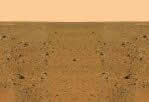| |
Before
the era of space probes, many astronomers believed that the Martian
atmosphere was a relatively dense blanket that might even be able
to support life. But from the 1960s onward, orbiting spacecraft
and landers beamed back the disappointing news: The air on Mars
was thin, desperately cold and composed mainly of life-choking
carbon dioxide. It may not always have been so. The same spacecraft
have also found evidence that Martian air might once have been
as thick as the Earth's.
|
| Absent
Air |
Mars'
atmosphere is laden with red dust, and its pink skies are some
of the most scenic in the solar system. But any space tourist
would certainly need a pressure suit to survive. At the surface.
Mars has an atmospheric pressure of no more than 10 millibars.
On Earth, you would have to travel to 120,000 feet, four times
the height of Mount Everest, to reach such thin air.
|
What
gas there is on Mars is mainly carbon dioxide, a greenhouse gas.
But there is not nearly enough of it to warm up the chilly planet.
Mars' atmosphere contributes only about 12°F to the average
temperature of -65°F. On Earth, carbon dioxide makes up less
than one percent of the air, but raises temperatures by around
63°F.
|
Scientists
once thought that Mars' atmosphere was mainly made up of nitrogen,
like the air on Earth. But the Viking landers uncovered the more
inhospitable truth in 1976, when they found that only three out
of every hundred air molecules were nitrogen. Mars was not so
short of nitrogen in the past. Atoms come in various isotopes—each
with a different weight. Martian air contains a higher proportion
of heavy nitrogen atoms than Earth's air: Many of the light isotopes
have escaped.
|
If
the young Mars did have a thicker atmosphere, the puzzle of its
water-based features would be solved. The very thin, very cold
Martian air means that water cannot exist as a liquid now—it
appears as ice or vapor. Only flowing water in a thicker, warmer
atmosphere could have shaped the channels recorded by the Mars
orbiters.
|
| Gas
Escape |
So
where is all the missing air? Some of it may have simply drifted
away. The Red Planet has low gravity— only one-third of that
on Earth—that is too weak to hang on to many air particles.
Other parts of the atmosphere were removed more violently. Mars
was bombarded by meteors in its early history, and much of the
atmosphere was literally blasted into space. But other planets
also came into the line of fire—and still managed to cultivate
healthy second atmospheres.
|
One
theory suggests that some of the Martian air was carried away
by the solar wind. On Earth, the air is shielded by our planet's
magnetic field. On Mars, the magnetic field is too weak to offer
much protection. Atoms in the upper atmosphere are ionized—given
an electrical charge—by sunlight. The solar wind sweeps these
charged particles out into space. Lighter atoms are the easiest
to pluck away, and the heavyweight molecules that make up the
majority of the air now are the only ones left.
|
The
liquid water that excavated rivers and channels on the young planet
may also have destroyed much of the atmosphere. Carbon dioxide
probably dissolved in the water, to be deposited later as carbonate
minerals. The discovery of carbon in Martian meteorites supports
this idea. The same process takes place on the Earth, with one
essential difference—Earth has volcanoes. Carbon dioxide
is absorbed into the Earth's surface in just the same way as it
is on Mars, and is eventually blasted back into the atmosphere
by lava flows.
|
But
the lockup of carbon dioxide in minerals is permanent on Mars:
There are no plate tectonics to free the trapped carbon. There
is evidence that Mars has had violent volcanic epochs in the past,
but the planet's surface is still now. Mars' missing atmosphere
is irretrievable—and the Red Planet will remain a cold, dry
and inhospitable desert.
|
|
|

|
|
|
|

| RED
COATING |
| Everything
on Mars, from rocks to space probes, becomes coated in layers
of red dust deposited by the atmosphere. |

| UV
DAMAGE |
Any
human visitors to Mars would certainly need a very good sunblock.
Unlike the Earth's air, the Martian atmosphere does not have
an ozone layer to filter out ultraviolet (UV) radiation.
|


| LITTLE
VENUS |
In
percentage terms, the composition of Mars 7 atmosphere is very
similar to that of Venus—it is just a great deal thinner.
|
|
|

![]()



